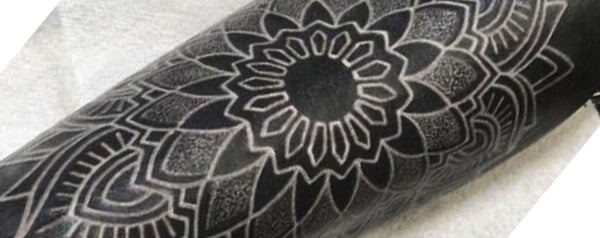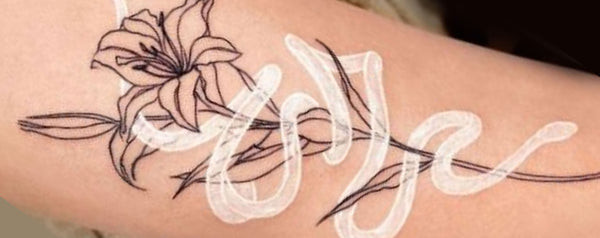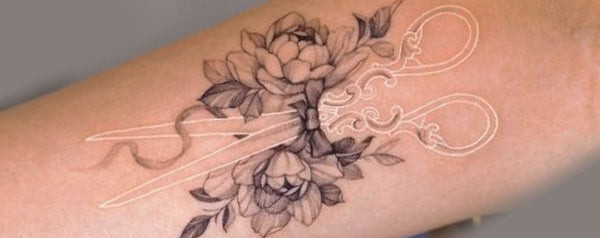Can You Put White Ink Over Black Tattoo? Yes, you can put white ink over a black tattoo, and this guide from tattooat.com will explore the process, challenges, and considerations for achieving the best results with this unique tattoo technique. Whether you’re looking to refresh an old tattoo, add highlights, or create a stunning contrast, understanding the nuances of white ink on black ink is essential for a successful outcome, offering insights into white tattoo pigment, tattoo cover-up options, and tattoo aftercare tips.
1. Understanding White Ink Tattoos
White ink tattoos stand out as a subtle yet striking alternative to traditional black or colored tattoos. Their delicate, almost ethereal appearance makes them a popular choice for those seeking a minimalist or understated look. Unlike darker inks, white ink offers a unique canvas for creative expression, blending artistry with personal style.
1.1. The Appeal of White Ink
White ink tattoos offer a unique aesthetic that appeals to those seeking a subtle yet striking form of body art. The ethereal quality of white ink creates a delicate, almost lace-like appearance on the skin, providing a minimalist alternative to traditional black or colored tattoos. According to Inked Magazine, white ink tattoos are becoming increasingly popular among individuals who desire a less conspicuous tattoo that still allows for creative expression.
1.2. Skin Tone Considerations
The visibility of white ink tattoos is heavily influenced by skin tone. They tend to show up best on fair to medium skin, where the contrast between the ink and the skin is more pronounced. People with darker complexions may find that the white ink doesn’t stand out as much, and it might even appear yellowish or fade more quickly. It’s crucial to consider your skin tone when deciding if a white ink tattoo is the right choice for you.
1.3. Minimalist Design
White ink tattoos often lend themselves to minimalist designs, emphasizing fine lines and subtle shading. This approach allows for intricate details to be highlighted without overwhelming the skin. The minimalist aesthetic of white ink tattoos appeals to those who appreciate simplicity and elegance in their body art, offering a sophisticated and understated form of self-expression.
 Minimalist white ink tattoo on wrist
Minimalist white ink tattoo on wrist
2. Choosing the Right White Tattoo Ink
Selecting the right white tattoo ink is crucial for achieving vibrant and long-lasting results. Not all inks are created equal, and the quality of the ink can significantly impact the appearance and longevity of your white ink tattoo. Choosing a reputable brand and formulation is essential for ensuring the best possible outcome.
2.1. Top White Ink Brands
Several renowned brands in the tattoo industry offer white inks specially formulated to retain their brightness and consistency. Eternal Ink, Fusion, and Solid Ink are among the most popular choices, known for their high-quality pigments and reliable performance. These brands have earned a reputation for producing white inks that deliver consistent results, making them a favorite among tattoo artists.
Here’s a quick look at some of the best-selling white inks from these top brands:
| Brand | Product Name | Key Features |
|---|---|---|
| Eternal Ink | Eternal White Ink | Highly concentrated pigment, smooth consistency, excellent for highlights |
| Fusion | Fusion White Ink | Bright, opaque white, long-lasting, vegan-friendly |
| Solid Ink | Solid White Ink | Consistent color, easy to work with, suitable for various skin tones |
2.2. Factors to Consider When Choosing Ink
When selecting white tattoo ink, consider factors such as pigment concentration, consistency, and reputation of the manufacturer. High pigment concentration ensures that the ink will appear bright and opaque on the skin, while a smooth consistency makes it easier for the artist to work with. Reading reviews and seeking recommendations from experienced tattoo artists can also help you make an informed decision.
2.3. Artist Recommendations
Experienced tattoo artists can provide valuable insights into the best white inks for different skin tones and tattoo styles. They can recommend inks based on their personal experience and the results they’ve achieved with various brands and formulations. Consulting with a reputable artist can help you choose the right ink for your specific needs and preferences.
 Close-up of white ink tattoo on arm
Close-up of white ink tattoo on arm
3. White Ink Over Black: The Possibilities and Challenges
One of the most frequently asked questions about white ink tattoos is whether they can be applied over existing black tattoos. While it is possible to cover black tattoos with white ink, the process presents unique challenges and the results may vary depending on several factors. Understanding these challenges is essential for setting realistic expectations and achieving the best possible outcome.
3.1. Can White Ink Cover Black Ink?
Yes, white ink can be used to overlay or cover up black tattoos, but it’s important to understand the limitations. According to research from Portland State University’s Art Department, in July 2023, while white ink can create a contrast and add dimension to a black tattoo, it will not completely erase the black ink. The black ink will always be visible to some extent, influencing the final appearance of the white ink tattoo.
3.2. Factors Affecting the Outcome
Several factors can affect the outcome of applying white ink over black ink, including the age, darkness, and saturation of the existing black tattoo. Fresh, dark tattoos are more challenging to cover, as the ink is still highly concentrated. Older, faded tattoos offer a more stable foundation for white ink, but the underlying black ink will still impact the final result.
3.3. The Role of a Skilled Artist
The success of a white ink cover-up largely depends on the skill and experience of the tattoo artist. An artist specializing in color correction and cover-up techniques can assess the existing tattoo and determine the best approach for achieving the desired outcome. They can also advise on the most suitable white ink and application techniques for the specific tattoo and skin tone.
4. Longevity of White Ink Tattoos
One of the primary concerns with white ink tattoos is their longevity. Compared to black or colored tattoos, white ink tends to fade more quickly and may require more frequent touch-ups to maintain its vibrancy. Understanding the factors that affect the longevity of white ink tattoos can help you make informed decisions about aftercare and maintenance.
4.1. Factors Influencing Fading
Several factors can influence the rate at which white ink tattoos fade, including sun exposure, skin hydration, and overall skin health. Sun exposure is a major culprit, as UV rays can break down the pigment in the ink, causing it to fade. Dry skin can also contribute to fading, as the ink is not as well-retained in dehydrated skin.
4.2. Skin Care and Maintenance
Proper skin care and maintenance are essential for preserving the vibrancy of white ink tattoos. Regularly moisturizing the skin can help keep it hydrated and prevent the ink from fading. Applying sunscreen to the tattooed area whenever exposed to the sun can also protect the ink from UV damage.
4.3. Touch-Up Frequency
Due to the tendency of white ink to fade more quickly, touch-ups are often necessary to maintain the desired appearance. The frequency of touch-ups will vary depending on individual factors such as skin type, sun exposure, and aftercare practices. However, most people with white ink tattoos can expect to need touch-ups every few years to keep their tattoos looking fresh.
 White ink tattoo on back with intricate design
White ink tattoo on back with intricate design
5. Healing Process for White Ink Tattoos
Healing a white ink tattoo requires patience and proper aftercare. The healing process can be slightly different from that of traditional tattoos, and it’s important to be aware of the potential challenges and how to address them. Following your artist’s aftercare instructions carefully can help ensure a smooth and successful healing process.
5.1. Initial Appearance
During the initial healing phase, a white ink tattoo may appear raised or puffy. This is a normal reaction as the skin heals and should subside within a few days. The tattoo may also look reddish due to inflammation, but this should also fade as the healing progresses.
5.2. Temporary Color Changes
It’s common for white ink tattoos to exhibit temporary color changes during the healing process. The ink may appear yellowish or even slightly transparent as the skin regenerates. These changes are usually temporary and the true color of the white ink will emerge as the skin fully heals.
5.3. Post-Healing Care
Once the tattoo has fully healed, it’s important to continue to care for it properly to maintain its appearance. Regular moisturizing and sun protection are essential for preventing fading and keeping the white ink looking its best. Avoiding harsh chemicals and abrasive cleansers can also help preserve the vibrancy of the tattoo.
6. Pain Perception and White Ink Tattoos
One common myth surrounding white ink tattoos is that they are more painful than traditional tattoos. While pain perception is subjective and varies from person to person, there is no scientific evidence to suggest that white ink tattoos are inherently more painful. The sensation of pain during tattooing is influenced by several factors, including individual tolerance, the location of the tattoo, and the technique used by the artist.
6.1. Factors Influencing Pain
Individual pain tolerance plays a significant role in the perceived level of discomfort during tattooing. Some people have a higher pain threshold than others, and what one person finds tolerable, another may find excruciating. The location of the tattoo can also affect pain levels, with areas that are closer to bone or have more nerve endings tending to be more sensitive.
6.2. Density of Ink
Some people believe that white ink tattoos are more painful because the ink is often packed more densely to achieve the desired opacity. While it’s true that white ink may require more passes to achieve the desired effect, this does not necessarily translate to increased pain. A skilled artist can adjust their technique to minimize discomfort while still achieving optimal results.
6.3. Managing Pain
If you’re concerned about pain during a white ink tattoo session, there are several techniques you can use to manage discomfort. Deep breathing, meditation, and visualization can help distract you from the pain. You can also communicate with your artist about any discomfort you’re experiencing, and they may be able to adjust their technique or take breaks as needed.
 Woman getting white ink tattoo on shoulder
Woman getting white ink tattoo on shoulder
7. Cost Considerations for White Ink Tattoos
The cost of a white ink tattoo can vary depending on several factors, including the size, complexity, and location of the tattoo, as well as the artist’s experience and reputation. While white ink tattoos may be slightly more expensive than traditional tattoos due to the specialized techniques and inks required, the investment can be worth it for those seeking a unique and understated form of body art.
7.1. Factors Affecting Price
The size and complexity of the tattoo are major determinants of price. Larger, more intricate designs will require more time and ink, and therefore will cost more. The location of the tattoo can also affect the price, with areas that are more difficult to access or require more precision tending to be more expensive.
7.2. Artist Expertise
The artist’s experience and reputation can also influence the price of a white ink tattoo. Highly skilled and sought-after artists typically charge more for their services, but their expertise can ensure a better outcome and a more enjoyable experience. Investing in a reputable artist is often worth the extra cost, as it can make a significant difference in the quality and longevity of your tattoo.
7.3. Investing in Quality
When it comes to tattoos, quality often trumps cost. While it may be tempting to opt for a cheaper option, investing in a professional artist who specializes in white ink tattoos can mean the difference between a vibrant, long-lasting piece of art and a muted, quickly fading disappointment. Remember, a tattoo is a permanent investment in your body and self-expression, so it’s worth spending a little more to ensure the best possible outcome.
8. Finding a Reputable Tattoo Artist
Finding a reputable tattoo artist is essential for a safe and successful white ink tattoo experience. A skilled artist can assess your skin tone, recommend the best ink and design for your needs, and apply the tattoo with precision and care. Researching artists and studios in your area and reading reviews can help you find an artist who is qualified and experienced in working with white ink.
8.1. Researching Artists
Start by researching tattoo artists and studios in your area. Look for artists who specialize in white ink tattoos or have a strong portfolio of minimalist and fine-line work. Check out their websites and social media pages to see examples of their work and read reviews from previous clients.
8.2. Checking Credentials
Make sure the artist you choose is licensed and certified to practice tattooing in your state. This ensures that they have met the necessary requirements for safety and hygiene. You can also check with your local health department to see if there have been any complaints or violations filed against the artist or studio.
8.3. Consulting with the Artist
Before committing to a white ink tattoo, schedule a consultation with the artist. This is an opportunity to discuss your design ideas, ask questions about the process, and assess the artist’s expertise and professionalism. A good artist will be able to provide guidance and recommendations based on your skin tone, tattoo goals, and lifestyle.
9. White Ink Tattoo Designs: Inspiration and Ideas
White ink tattoos offer a unique canvas for creative expression, allowing for a wide range of designs and styles. From minimalist symbols to intricate patterns, the possibilities are endless. Exploring different design ideas can help you find the perfect white ink tattoo that reflects your personality and style.
9.1. Minimalist Symbols
Minimalist symbols are a popular choice for white ink tattoos, offering a subtle yet meaningful form of self-expression. Simple shapes, lines, and geometric patterns can be used to create elegant and understated designs that complement the delicate nature of white ink.
9.2. Fine Line Work
Fine line work is another popular option for white ink tattoos, allowing for intricate details and delicate shading. This style is well-suited for creating lace-like patterns, floral designs, and other intricate motifs that showcase the ethereal quality of white ink.
9.3. Geometric Patterns
Geometric patterns offer a modern and stylish option for white ink tattoos. These designs can range from simple geometric shapes to complex tessellations, creating visually striking and unique tattoos that stand out from traditional designs.
10. White Ink Tattoo Aftercare: A Step-by-Step Guide
Proper aftercare is essential for ensuring a smooth and successful healing process for your white ink tattoo. Following your artist’s aftercare instructions carefully can help prevent infection, minimize scarring, and preserve the vibrancy of your tattoo. This step-by-step guide provides a comprehensive overview of white ink tattoo aftercare.
10.1. Immediate Aftercare
After getting your white ink tattoo, your artist will apply a bandage or protective covering to the area. Leave this covering in place for the amount of time recommended by your artist, typically a few hours to overnight. This will help protect the tattoo from bacteria and other contaminants.
10.2. Cleaning the Tattoo
Once you remove the bandage, gently clean the tattoo with mild soap and warm water. Avoid using harsh soaps or abrasive cleansers, as these can irritate the skin and damage the tattoo. Pat the area dry with a clean towel, being careful not to rub or scrub the tattoo.
10.3. Moisturizing the Tattoo
After cleaning the tattoo, apply a thin layer of a fragrance-free, hypoallergenic moisturizer. This will help keep the skin hydrated and prevent it from drying out. Apply moisturizer several times a day, especially after showering or washing the tattoo.
10.4. Avoiding Sun Exposure
Sun exposure can cause white ink tattoos to fade more quickly, so it’s important to protect your tattoo from the sun. Avoid direct sun exposure as much as possible, and when you do go outside, apply a broad-spectrum sunscreen with an SPF of 30 or higher to the tattooed area.
10.5. Monitoring for Infection
Keep an eye on your tattoo for signs of infection, such as redness, swelling, pus, or excessive pain. If you notice any of these symptoms, contact your artist or a medical professional immediately. Early treatment of infection can prevent serious complications and ensure a successful healing process.
By understanding the nuances of white ink tattoos, from their unique appeal to the challenges of applying them over black ink, you can make informed decisions and achieve stunning results. Whether you’re looking for a subtle accent or a complete cover-up, white ink offers a versatile and artistic way to express yourself.
Ready to explore the world of white ink tattoos? Visit tattooat.com for inspiration, artist recommendations, and expert advice on everything tattoo-related. Discover stunning designs, find talented artists in your area, and learn the best aftercare practices to keep your ink looking vibrant for years to come. Let tattooat.com be your guide to the art of self-expression through tattoos.
Address: 1825 SW Broadway, Portland, OR 97201, United States
Phone: +1 (503) 725-3000
Website: tattooat.com
FAQ: White Ink Over Black Tattoos
1. Can white ink completely cover a black tattoo?
No, white ink cannot completely cover a black tattoo. The black ink will always be visible to some extent, influencing the final appearance of the white ink tattoo.
2. Is it more painful to get white ink over a black tattoo?
Pain perception varies, but there’s no evidence white ink tattoos are inherently more painful. The sensation depends on individual tolerance, tattoo location, and the artist’s technique.
3. How long do white ink tattoos last before they fade?
White ink tattoos tend to fade more quickly than black or colored tattoos, typically requiring touch-ups every few years to maintain their vibrancy.
4. What skin tones are best suited for white ink tattoos?
White ink tattoos show up best on fair to medium skin tones, where the contrast between the ink and the skin is more pronounced.
5. How do I find a reputable tattoo artist for white ink tattoos?
Research artists with experience in white ink tattoos, check their credentials, and consult with them to discuss your design ideas and assess their expertise.
6. What are some popular design ideas for white ink tattoos?
Popular design ideas include minimalist symbols, fine line work, and geometric patterns, which complement the delicate nature of white ink.
7. How should I care for my white ink tattoo after getting it?
Follow your artist’s aftercare instructions, which typically include cleaning the tattoo gently, moisturizing it regularly, and avoiding sun exposure.
8. Are white ink tattoos more expensive than black ink tattoos?
White ink tattoos may be slightly more expensive due to the specialized techniques and inks required, as well as the potential need for multiple passes.
9. Can white ink be used to add highlights to a black tattoo?
Yes, white ink can be used to add highlights and create contrast in a black tattoo, enhancing its depth and dimension.
10. What should I do if my white ink tattoo starts to fade?
If your white ink tattoo starts to fade, schedule a touch-up appointment with your artist to restore its vibrancy.
